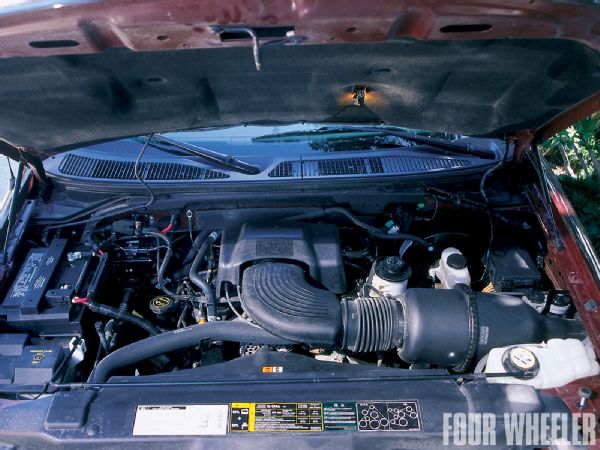
F-150 Air/Fuel/Fluid Problems
Q My vehicle is an '02 Ford F-150 Crew Cab Lariat 4x4, stock. I have two problems:
Problem 1: After driving in stop-and-go traffic, the truck will idle very low and occasionally stop running. Sometimes it idles rough, and then proceeds to die. Crank, hit the gas pedal, and off I go, but with very little power. And if the gas pedal is released, it dies too.

I suspect that temperature (bad vaporization of fuel? I've already added Lucas gas additive, to no avail) or a leaking vacuum line is the culprit. Any thoughts?
Problem 2: 7,000 miles ago, I changed the transmission fluid, using Pennzoil ATF and the best trans-fluid additive I could find. After this was done, I realized that the trans dipstick states: "Mercon V only." At that time I could not find the stuff other than in the dealership, but I prefer Castrol and Lucas additive. Question 1: Does Castrol make Mercon V-compliant oil? Question 2: Would you recommend Lucas Trans Additive? The truck has close to 80,000 miles, and I'm looking to changing the differential, transmission and transfer-case oils. Question 3: Will this prevent the gear hunting/erratic shifting that my tranny is doing, or it has something to do with Problem 1?
I would really appreciate your help, since I don't have any competent mechanic near my place other than the dealership, and they're questionable too.
Francisco Castro
Via fourwheeler.com
A There are a lot of things that could be causing problem #1. The first thing that you should do is have a qualified mechanic take a look with a scanning tool and see if there are any trouble codes. These stored trouble codes can offer a world of information in solving the problem. I would just be guessing in anything that I say, but here are my somewhat educated guesses anyway.
The first thing I would look for-and it will only cost you a bit of time to search out-is a disconnected or leaking vacuum hose. Tug, pull, and check out each and every hose you can find. A lot more accurate way would be to use a Rotunda Vacutec 522 smoke leak detector machine (or something similar). But then again, you don't have access to one, so use your eyes.
The idle air control (IAC) valve assembly controls engine idle speed and provides a dash pot function. The IAC valve assembly meters intake air around the throttle plate through a bypass within the IAC valve assembly and throttle body. The power control module (PCM) determines the desired idle speed or bypass air, and signals the IAC valve assembly through a specified duty cycle. The IAC valve responds by positioning the valve to control the amount of bypassed air. The PCM monitors engine rpm, and increases or decreases the IAC duty cycle in order to achieve the desired rpm. The OE part number is YL3Z9F715AA, and the cost is about $120.
Ford used at least two different manufacturers of this item. The valve is not repairable or cleanable. I am not saying that this is the problem, but just one of the things that could cause the problem.
As to problem # 2: Always use the transmission fluid that is recommended by the vehicle manufacturer. Any other fluid may not be compatible with the internal components, especially the clutch plate material. Yes, automatic transmissions have clutches that engage and disengage between gear changes and have certain friction requirements. Using the wrong fluid-and even transmission additives-that may or may not be compatible with even the proper fluid can cause all sorts of shifting problems, and very possibly the ones you're experiencing. You need to read the labeling on the fluid package as it will state what requirements that it meets, such as if it does meet the Mercon V requirements.
While there are quite a few additives available for engine oil, transmission fluid, and gear lube, it is hard to say if they really add any real benefit. The only way to really find out would be to have a testing lab do some extensive (and expensive) tests with each particular brand of lubricant used, as each has a slightly different additive package. I suggest that you drain the present fluid out of your transmission and start over again. Unfortunately, what is in the torque converter will not drain out, so you may have to make several transmission fluid changes after driving the vehicle a few miles to remove the majority of the "wrong" fluid.
Mystery Death Wobble In JK Unlimited
Q In March 2009 I purchased my first Jeep, an '09 JK Wrangler X Unlimited. In April I had a Zone Off-Road 3-inch suspension lift installed. I put on Pro Comp 17x9 Knight Khrome wheels with 35x12.50/17 Pro Comp Xtreme M/Ts. I also had a JKS adjustable track bar installed shortly afterward. Everything has been great until I put my factory tires and wheels back on for the harsh Ohio winter (a lot of road salt and brine water also). The factory tires are Goodyear Wrangler SR-As, 255/75R17s on the factory wheels.
I am having a problem with a "death wobble" at freeway speeds (65 to 70 mph) when I go over a bump on the freeway. The installation shop and I have both called Zone and BDS about this. They recommended that we install two-degree caster cam plates on the lower control arms. After the install, the death wobble was present at lower speeds of 30 to 40 mph. I drove back to the off-road shop and we adjusted the toe. The wobble is still present, and we are going to adjust the toe some more and balance the tires to see if they're out of balance. We have made sure everything under the front end is tight and to torque specifications.
I have not been off road with the Jeep yet, so it's mainly on the street, and is my daily driver. This is driving me nuts and is very frustrating. Is this common when switching back to the factory tires and wheels? Am I going to have to re-align the vehicle every time I change my tires for the seasons? Any suggestions, input, or ideas?
Lou Keller
Cuyahoga Falls, OH
A It's kind of strange that the death wobble took place after you put the old factory stock tires back on and did not happen with the larger tires. If I read your email correctly, you made no other changes to the Jeep besides changing tires. Once the alignment has been set, it should not need to be changed. Some shops like to run a bit more toe-in with larger tires, as the tire seems to have a bit more leverage and push outward. But then again, toe should not have any bearing on the death wobble situation. Usually, improper toe-in causes the vehicle to wander, not wobble.
I would think that you would need about five degrees of caster angle. You said that you added two additional degrees of caster, but not what total caster was set at. Yes, lack of proper caster can help promote death wobble, but I would think that it would also be present with the 35-inch tires.
My first thought is that the stock tires are badly out of balance. Could you have run the tires at a very low pressure and spun them slightly on the rims? Could it be that somehow you used an air system that had a considerable amount of moisture in it and it was transferred to the tires? A chunk of ice would greatly affect the tire's balance and cause the wobble. Are the factory wheels sitting true on the hub with no interference from spacers of any kind?
If these things all check out, I would suggest going back to a hands-on approach to all the suspension components. Pull, tug, and pry on every mounting location, every tie-rod end and bushing, and search for movement. Jack a wheel off the ground and grab it at the top, and check for any in-and-out movement such as would come from the wheel bearings. Then grab the front of the tire and try moving it in and out. Have a helper watch for movement. Sometimes the smallest amount of wear can cause a death wobble.
Finally, when the Jeep was on the alignment rack, did they check for proper axle camber? When used very hard, it's not uncommon for JKs to bend a front axlehousing; however, this shouldn't cause a death wobble.
Chevy 454 Big-Block: Turbo or No?
Q I have an '89 Chevrolet K-2500 with a '91 454ci V-8 and overdrive automatic transmission. I was wondering what your feelings are about adding a dual turbocharger setup versus a single turbo. The motor is completely stock and has no add-ons. If I do plan on putting on one of the turbo setups, I am definitely adding bigger injectors to the truck. I would like your input on what I have to do to make this work on my truck; I am planning on using the STS Universal systems.
Darren
Via fourwheeler.com
A While STS makes some great systems, they are primarily designed for use on street-driven vehicles. Because it's an "under-vehicle system," there is a heck of a lot of plumbing involved. Plus, they do not make a specific kit for your truck, and as you mentioned, you plan to use their universal system. This means you're going to have to fabricate all the exhaust tubing from the engine back to the turbo(s) and then back up to the engine, snaking past the transfer case and front driveshaft. There is also the issue of maintaining proper clearances for off-road travel.
Because dirt is one of the real enemies of a turbocharger, you would need some way to mount the air intake within a protected area of the bed. I really would recommend not going with such a kit and to investigate some other kit designed specifically for your truck.
As to one or two turbochargers? You're getting pretty serious with two turbos, meaning you're planning on making lots and lots of horsepower. If this is the case, you're going to have to make many more modifications other than just adding bigger injectors to your truck. Engine-wise, it will require at least stronger connecting rods and forged pistons of the proper dome shape and compression, along with an updated ignition system.
I think that the TH700R4 in your truck is a great transmission, but unless you have a very expensive rebuild done by a company that specializes in such, it won't live very long behind the added power.
Oh, and as to going to bigger injectors, that may be difficult, as your truck uses a throttle-body injection system. The real problem is not just adding larger injectors, but getting enough airflow to handle the turbo's demands. Holley offers some help in this area. You would also need to upgrade the fuel delivery system with bigger-diameter fuel lines and a larger-capacity fuel pump.
Where To Write
Address your correspondence to: Four Wheeler, 831 S. Douglas St., El Segundo, CA 90245. All letters become the property of Four Wheeler, and we reserve the right to edit them for length, accuracy, and clarity. The editorial department can also be reached through the website at www.fourwheeler.com. Due to the volume of mail, electronic and otherwise, we cannot respond to every reader, but we do read everything.